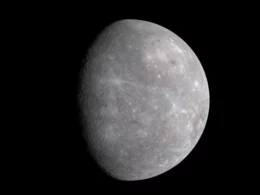Mercury is the smallest planet in the solar system and the closest one to the sun. It is also one of the most intriguing celestial bodies, with its unique features and characteristics. One of the most interesting things about Mercury is the length of its day, which is much longer than its year.
A day on Mercury lasts about 59 Earth days, which is the time it takes for the planet to complete one rotation on its axis. This means that a day on Mercury is almost two-thirds of its entire year, which lasts about 88 Earth days. This is due to the fact that Mercury rotates very slowly, taking almost 59 Earth days to complete one rotation, while it takes only 88 Earth days for it to orbit around the sun.
The length of a day on Mercury is one of the most fascinating aspects of this planet, and it has been the subject of much scientific study and research. Understanding the length of a day on Mercury is important for scientists who are studying the planet, as it can help them to better understand its unique characteristics and how it fits into the larger solar system.
Mercury’s Rotation and Orbit
Orbital Characteristics
Mercury’s orbit around the Sun is highly elliptical, with a perihelion (closest point to the Sun) of 46 million km and an aphelion (farthest point from the Sun) of 70 million km. This makes it the planet with the most eccentric orbit in the solar system. It takes Mercury 88 Earth days to complete one orbit around the Sun, which is the equivalent of one Mercury year.
Rotation Period
Mercury’s rotation period is unique in the solar system. It rotates on its axis once every 59 Earth days, which is the equivalent of one Mercury solar day. However, because of its elliptical orbit, Mercury’s rotation period is different from its orbital period. A sidereal day on Mercury, which is the time it takes for the planet to make one complete rotation on its axis, is 58.6 Earth days. This difference between a solar day and a sidereal day is due to the planet’s orbital motion around the Sun.
Mercury’s rotation axis is tilted at an angle of only 2.11 degrees relative to its orbit around the Sun. This means that there are no significant seasonal variations on the planet’s surface. However, because of its slow rotation and close proximity to the Sun, the temperature on Mercury’s surface can vary greatly between its day and night sides. During its day, temperatures can reach highs of 800°F (430°C), while at night they can drop to -290°F (-180°C).
In summary, Mercury’s orbit around the Sun is highly elliptical, taking 88 Earth days to complete one orbit. Its rotation period is unique, with a solar day of 59 Earth days and a sidereal day of 58.6 Earth days. Mercury’s slow rotation and close proximity to the Sun result in extreme temperature variations on its surface.
Comparing Mercury to Earth
Day Length Comparison
Mercury is the planet closest to the sun and is the smallest planet in the solar system. Due to its proximity to the sun, it has a shorter year than Earth, taking only 88 Earth days to complete one orbit around the sun. However, its day is much longer than Earth’s day. A day on Mercury lasts approximately 58.6 Earth days, which is almost two-thirds of its year. This means that one day on Mercury is almost as long as two years on Mercury.
In comparison, Earth takes 24 hours to complete one rotation on its axis, which is known as a solar day. The solar day on Mercury, on the other hand, lasts 176 Earth days. This means that one day on Mercury is almost seven times longer than a day on Earth.
Frequently Asked Questions
How does the length of a day on Mercury compare to a day on Earth?
A day on Mercury is much longer than a day on Earth. While an Earth day is approximately 24 hours, a day on Mercury lasts about 59 Earth days.
What is the duration of a full rotation of Mercury on its axis?
Mercury rotates very slowly on its axis, taking approximately 59 Earth days to complete one full rotation. This means that one day on Mercury is equal to one full rotation.
How does Mercury’s day length relate to its proximity to the Sun?
Mercury’s proximity to the Sun affects the length of its day. Due to its close proximity, Mercury experiences a strong gravitational pull from the Sun, which has caused it to become tidally locked. This means that one side of the planet always faces the Sun, while the other side is in perpetual darkness.
What factors contribute to the unique rotation period of Mercury?
Several factors contribute to the unique rotation period of Mercury. One of the most significant is its proximity to the Sun, which causes it to experience a strong gravitational pull. Additionally, Mercury’s small size and lack of a significant atmosphere also contribute to its slow rotation.
In what way does Mercury’s lack of moons affect the length of its day?
Mercury’s lack of moons does not directly affect the length of its day. However, the gravitational influence of other planets in the solar system can cause slight variations in Mercury’s rotation period over time.
How do the day lengths on Mercury and Venus differ?
The day lengths on Mercury and Venus are quite different. While a day on Mercury lasts approximately 59 Earth days, a day on Venus is much longer, lasting about 243 Earth days. This is due to Venus’ slow retrograde rotation, which causes it to rotate in the opposite direction of its orbit around the Sun.





